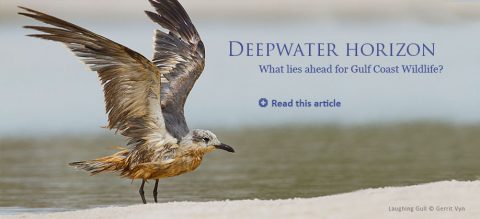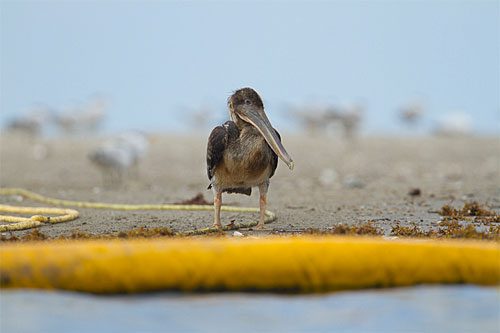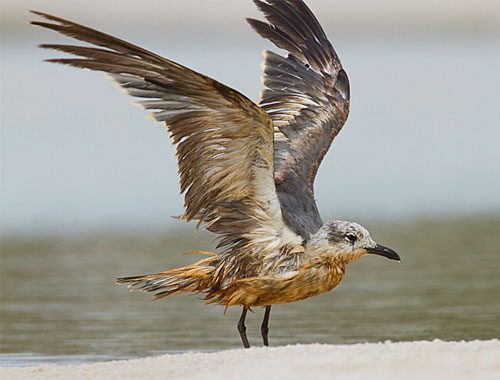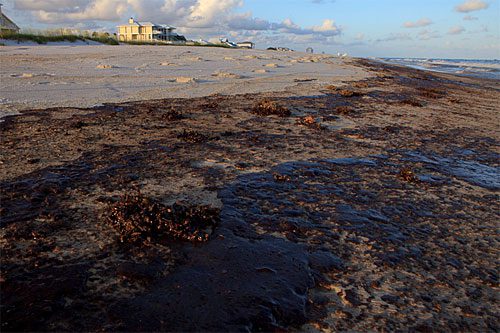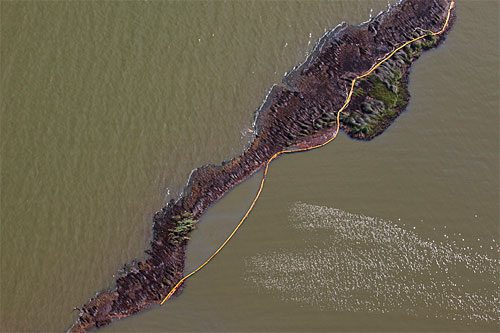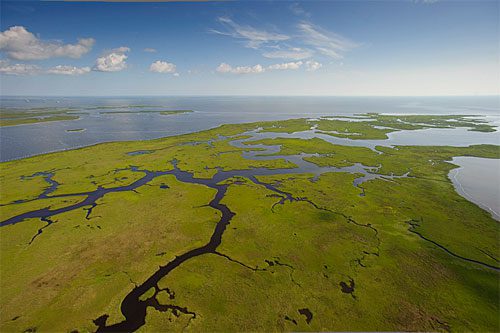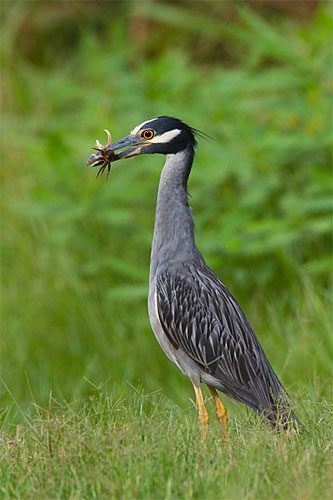Deepwater Horizon: What Lies Ahead for Gulf Wildlife?
By Hugh Powell; Photographs by Gerrit Vyn
October 15, 2010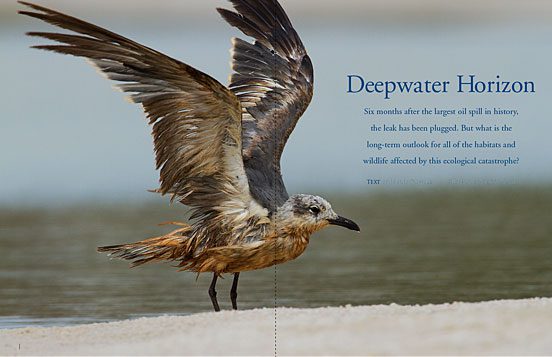
The Deepwater Horizon oil spill in the Gulf of Mexico was temporarily capped on July 15, 2010, just as the first Piping Plovers were arriving from their breeding grounds. By that time, reports of the total amount of oil spilled had shifted from using gallons to using barrels, neatly shaving off a digit but not otherwise diminishing the problem. The number was still big: 4.1 million barrels—more than 13 times the size of the Exxon Valdez spill, which until now provided our country’s mental image of environmental disaster. Deepwater Horizon is the largest accidental oil spill in history.
This past summer, I traveled to Louisiana with a team of biologists and videographers from the Cornell Lab. Our goal was to film as much of the bird life as possible in the Mississippi Delta, the Lower 48’s largest wetland complex, to make it less likely that impacts on bird species would be overlooked.
It is profoundly affecting to see the minutiae of a disaster. The luster of oil in grass, the way it hardens below the tide line, the bronzy, fake-tan tint it gives to a young egret or spoonbill, the number of men, boats, tanks, vacuum trucks, barges, and tugboats it takes to clean up a single inlet of a single oiled bay.
But even as it was being assailed by oil, the Delta was still a marvelous, teeming place of russet-tufted marsh grass, bruised clouds, and pastel birds, raucous as a thousand gulls and soft as the cough of a Least Bittern. Each day as our hired fishing boat puttered along through the saltmarsh, it was this juxtaposition, of unspoiled against despoiled, that made the situation real in both its desperateness and the slim hopes that persist.
The worst hits came in June and July—a time when you couldn’t turn on CNN without seeing mute pelicans crowded into rescue boxes slicked brown with oily goop. In August, the nation’s attention turned elsewhere. A National Oceanic and Atmospheric Administration (NOAA) report estimated that only about 25 percent of the spilled oil remained. Outside scientists quickly voiced their disagreements with this assessment, but even this estimate left a spill more than three times the size of Exxon Valdez floating on the water.
As far as birds are concerned, the saving grace has been that the spill happened 50 miles offshore, and the constant push of the Mississippi River helped keep the oil at bay. But that is also why it is so crucial to understand the spill’s aftermath. Oil that didn’t evaporate, wash ashore, or get digested by microbes will likely enter the food chain. According to NOAA estimates, that includes some 49 million gallons of chemically or naturally dispersed oil—more than four additional Exxon Valdez spills that we can’t even see.
This virtually invisible oil threatens birds in at least three main ecosystems: the barrier beaches, home to thousands of nesting seabirds and a resting stop for millions of migrating or wintering shorebirds; the saltmarsh and its bays, where wading birds feed and millions of waterfowl winter; and the open Gulf waters, where even the raw abundance of open-ocean birds is not yet well understood. It is essential that studies examine these ecosystems for evidence of long-term effects of the oil spill.
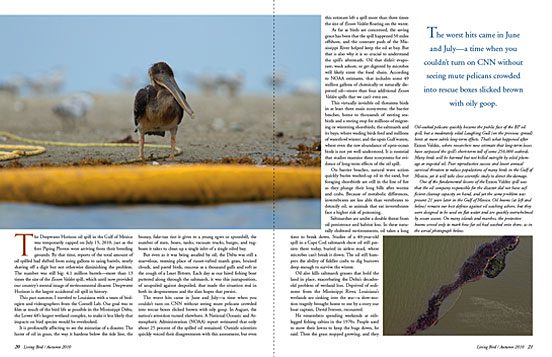
On barrier beaches, natural wave action quickly buries washed-up oil in the sand, but foraging shorebirds are still in the line of fire as they plunge their long bills after worms and crabs. Because of metabolic differences, invertebrates are less able than vertebrates to detoxify oil, so animals that eat invertebrates face a higher risk of poisoning.
Saltmarshes are under a double threat from oil persistence and habitat loss. In these naturally sheltered environments, oil takes a long time to break down. Studies of a 40-year-old spill in a Cape Cod saltmarsh show oil still persists there today, buried in airless mud, where microbes can’t break it down. The oil still hampers the ability of fiddler crabs to dig burrows deep enough to survive the winter.
Oil also kills saltmarsh grasses that hold the land in place, exacerbating the Delta’s decades-old problem of wetland loss. Deprived of sediment from the Mississippi River, Louisiana’s wetlands are sinking into the sea—a slow-motion tragedy brought home to me by a story our boat captain, David Iverson, recounted.
He remembers spending weekends at stilt-legged fishing cabins in the 1970s. People used to mow their lawns to keep the bugs down, he said. Then the grass stopped growing, and they put down rocks to walk on. Eventually the land flooded and people began mooring their boats directly under their houses. Finally, the houses were abandoned.
At one point we idled past one of these houses, empty, rotting, and out of sight of dry land. Magnificent Frigatebirds perched on the crooked timbers. A 2006 assessment (tellingly named “Drawing Louisiana’s New Map”) concluded that saving the state’s coastal wetlands was a 30- year job that would require a $14 billion investment. The arrival of oil only makes the plight of the saltmarsh and the birds that live there more desperate.
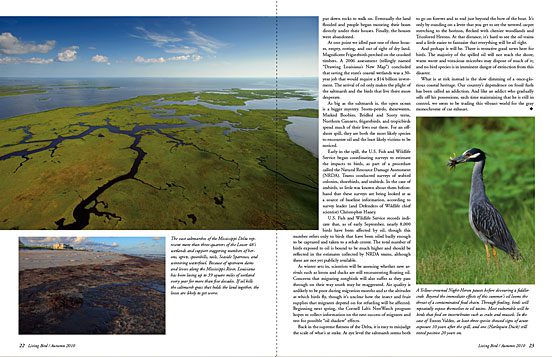
As big as the saltmarsh is, the open ocean is a bigger mystery. Storm-petrels, shearwaters, Masked Boobies, Bridled and Sooty terns, Northern Gannets, frigatebirds, and tropicbirds spend much of their lives out there. For an offshore spill, they are both the most likely species to encounter oil and the least likely victims to be noticed.
Early in the spill, the U.S. Fish and Wildlife Service began coordinating surveys to estimate the impacts to birds, as part of a procedure called the Natural Resource Damage Assessment (NRDA). Teams conducted surveys of seabird colonies, shorebirds, and seabirds. In the case of seabirds, so little was known about them beforehand that these surveys are being looked at as a source of baseline information, according to survey leader (and Defenders of Wildlife chief scientist) Christopher Haney.
U.S. Fish and Wildlife Service records indicate that, as of early September, nearly 8,000 birds have been affected by oil, though this number refers only to birds that have been oiled badly enough to be captured and taken to a rehab center. The total number of birds exposed to oil is bound to be much higher and should be reflected in the estimates collected by NRDA teams, although these are not yet publicly available.

Oil-soaked pelicans quickly became the public face of the BP oil spill, but a moderately oiled Laughing Gull (next slide) hints at more subtle long-term effects. Poor reproductive success and lower annual survival threaten to reduce populations of many birds in the Gulf of Mexico, yet it will take close scientific study to detect the damage. 
This oiled-but-still-alive Laughing Gull represents the long-term dangers of oil exposure: many birds will be harmed but not killed outright by oiled plumage or ingested oil. After the Exxon Valdez spill, researchers estimate that long-term losses grew to even greater than the spill's highly visible, short-term toll of some 250,000 seabirds. 
One of the fundamental lessons of the Exxon Valdez spill was that the oil company responsible for the disaster did not have sufficient cleanup capacity on hand, and yet the same problem was present 21 years later in the Gulf of Mexico. 
Oil booms remain our best defense against oil washing ashore, but they were designed to be used on flat water and are quickly overwhelmed by ocean waves. On many islands and marshes, the protective booms served only to mark how far oil had washed onto shore, as in this aerial photograph. 
The vast saltmarshes of the Mississippi Delta represent more than three-quarters of the Lower 48's wetlands and support staggering numbers of herons, egrets, spoonbills, rails, Seaside Sparrows, and wintering waterfowl. Because of upstream dams and levees along the Mississippi River, Louisiana has been losing up to 39 square miles of wetland every year for more than five decades. If oil kills the saltmarsh grass that holds the land together, the losses are likely to get worse. 
A Yellow-crowned Night-Heron pauses before devouring a fiddler crab. Beyond the immediate effects of this summer's oil looms the threat of a contaminated food chain. Through feeding, birds will repeatedly expose themselves to oil toxins. Most vulnerable will be birds that feed on invertebrates such as crabs and mussels. In the case of Exxon Valdez, at least three species showed signs of acute exposure 10 years after the spill, and one (Harlequin Duck) still tested positive 20 years on.
As winter sets in, scientists will be assessing whether new arrivals such as loons and ducks are still encountering floating oil. Concerns that migrating songbirds will also suffer as they pass through on their way south may be exaggerated. Air quality is unlikely to be poor during migration months and at the altitudes at which birds fly, though it’s unclear how the insect and fruit supplies that migrants depend on for refueling will be affected. Beginning next spring, the Cornell Lab’s NestWatch program hopes to collect information on the nest success of migrants and test for possible “oil shadow” effects.
Back in the supreme flatness of the Delta, it is easy to misjudge the scale of what’s at stake. At eye level the saltmarsh seems both to go on forever and to end just beyond the bow of the boat. It’s only by standing on a levee that you get to see the tattered carpet stretching to the horizon, flecked with chenier woodlands and Tricolored Herons. At that distance, it’s hard to see the oil stains and a little easier to fantasize that everything will be all right.
And perhaps it will be. There is tentative good news here for birds. The majority of the spilled oil will not reach the shore; warm water and voracious microbes may dispose of much of it; and no bird species is in imminent danger of extinction from this disaster.
What is at risk instead is the slow dimming of a once-glorious coastal heritage. Our country’s dependence on fossil fuels has been called an addiction. And like an addict who gradually sells off his possessions, each time maintaining that he is still in control, we seem to be trading this vibrant world for the gray monochrome of car exhaust.

All About Birds
is a free resource
Available for everyone,
funded by donors like you
American Kestrel by Blair Dudeck / Macaulay Library
